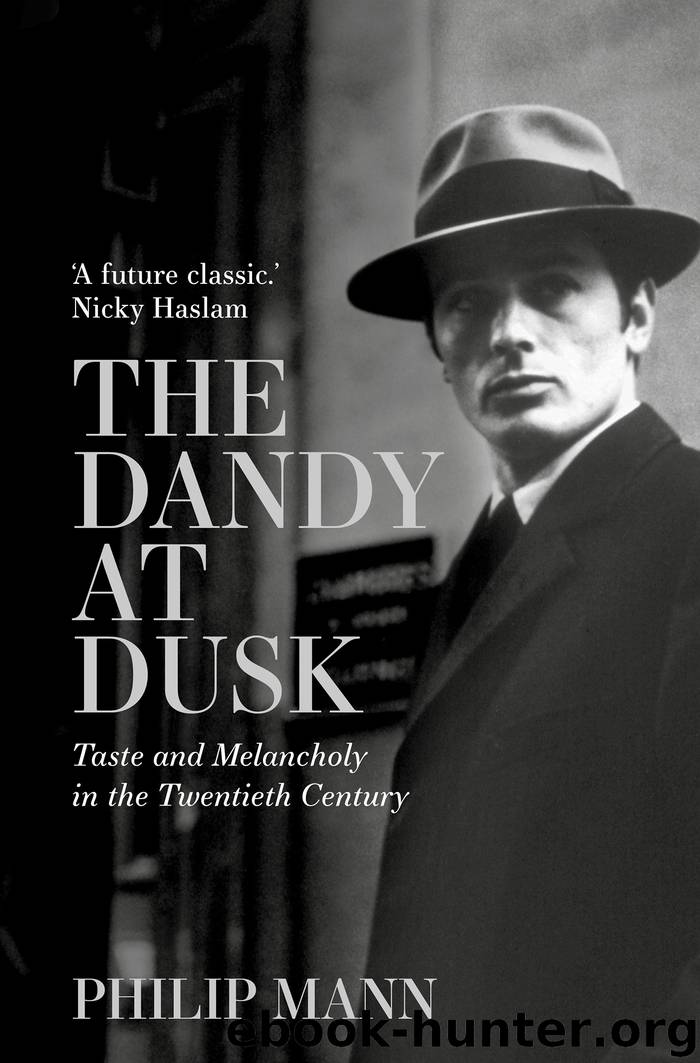The Dandy at Dusk by Mann Phillip;

Author:Mann, Phillip; [Mann, Philip]
Language: eng
Format: epub
Publisher: Head of Zeus
d.
Quentin Crisp getting ready to leave his cave. Photo © Homer Sykes Archive/Alamy Stock Photo.
QUENTIN CRISP
L’Étranger
She is an eighteenth-century woman, whose emotions turn instantaneously to wit.
REYNALDO HAHN ON MME DE CHEVIGNÉ
When all masks have fallen the true mystery begins.
JEAN COCTEAU
It is remarkable how every image of Quentin Crisp, even the most incidental, has something of an iconic quality. There are few others of whom this can be said, including perhaps William Burroughs and certainly that other self-created being, Andy Warhol. It is a quality that goes beyond great beauty or sexual attractiveness. Cartoon characters have it and film stars of Hollywood’s golden age in the 1920s, 1930s and 1940s had it. It is the art of always looking the same. Cartoon characters are drawn that way, and the stars of the golden age had an army of people making sure that the image stayed intact, even in supposedly private snaps. Quentin Crisp devoted a lifetime – almost literally – to perfecting this image of himself by himself, and not only did ensure that this image he presented to the world was perfect, but he also took great care – and herein lies an even more cogent reason for the striking quality of every single one of these portraits – that it was the most accurate depiction possible of the being underneath. Quite early on in a long life the two became inseparable. Quentin Crisp tampered with his personal appearance until it ‘unified’ him, and once he had adopted his ‘uniform’, the rest of his life ‘solidified’ around him ‘like a plaster cast’.1 Not for him the habit of ‘trying out a whole new image’ that is so prevalent among people in the worlds of fashion and popular culture. From that point on, Quentin Crisp remained impervious to fashion – indeed to change of any sort. His friend John Haggarty, whom he met in the 1940s, decided early on in their friendship that Crisp was ‘all of a piece, the front very formidable but bonded, like rubber and metal can be bonded, to the inner self which nobody knew’.2 While everyone is judged to a degree by how they look, this judgement will rarely be accurate. Creating this accuracy forms the groundwork of the dandy, and its successful results are the essence of his dandyism.
Quentin Crisp was born Denis Charles Pratt on Christmas Day 1908 in Sutton, Surrey, the youngest of four children. As so often, the original impulse that fostered the development of dandyism was a feeling of inadequacy. ‘I had two brothers and a sister and they were only semi-hopeless, but I couldn’t do any of it … I couldn’t cope with the world,’ he was to say of his childhood when looking back late in life.3 Contracting pneumonia as an infant left him with a taste for the attention that was heaped upon him at the expense of his siblings (he later claimed that ‘a fair share of everything is a starvation diet for an egomaniac),’4 as well
Download
This site does not store any files on its server. We only index and link to content provided by other sites. Please contact the content providers to delete copyright contents if any and email us, we'll remove relevant links or contents immediately.
| Advertising | Annuals |
| Book Design | Branding & Logo Design |
| Fashion Design | Illustration |
| Science Illustration |
Wonder by R.J. Palacio(8264)
Unlabel: Selling You Without Selling Out by Marc Ecko(3463)
Mastering Adobe Animate 2023 - Third Edition by Joseph Labrecque(3394)
Ogilvy on Advertising by David Ogilvy(3324)
Hidden Persuasion: 33 psychological influence techniques in advertising by Marc Andrews & Matthijs van Leeuwen & Rick van Baaren(3290)
Drawing Cutting Edge Anatomy by Christopher Hart(3289)
POP by Steven Heller(3227)
The Pixar Touch by David A. Price(3203)
The Code Book by Simon Singh(2853)
The Art of War Visualized by Jessica Hagy(2833)
The Curated Closet by Anuschka Rees(2797)
Slugfest by Reed Tucker(2796)
Rapid Viz: A New Method for the Rapid Visualization of Ideas by Kurt Hanks & Larry Belliston(2725)
Stacked Decks by The Rotenberg Collection(2682)
The Wardrobe Wakeup by Lois Joy Johnson(2632)
365 Days of Wonder by R.J. Palacio(2621)
Keep Going by Austin Kleon(2595)
Tell Me More by Kelly Corrigan(2519)
Tattoo Art by Doralba Picerno(2484)
